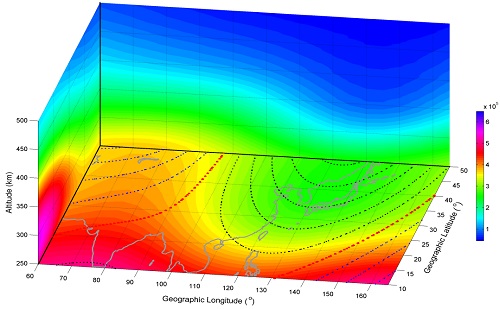Vice Professor ZHAO Biqiang and his team investigate the diurnal, seasonal, solar cycle, and height dependency of longitudinal variation of the ionosphere in the East Asia longitudes. They focus on observations made over the East Asia continent including three pairs of ionosondes distributed in the east and west of China, the electron density profiles (EDPs) derived from radio occultation (RO) technique of COSMIC/FORMOSAT-3 (a Constellation Observing System for Meteorology, Ionosphere, and Climate mission, here COSMIC for short), in situ plasma density measured from the Instrument Sonde de Langmuir (ISL) onboard the DEMETER satellite.
They demonstrate the similarity and discrepancy between the diurnal east-west asymmetry in the Eastern and Western Hemispheres and discuss the possible physical mechanisms.

Figure 1. Three-dimensional distribution of the plasma density over the Far East region at a fixed local time 10:00 LT during June 2007 with three slices represent the situation. (Image by ZHAO)
Zhao, B., et al. East-West Differences in F-region Electron Density at Midlatitude: Evidence from the Far East Region, J. Geophys. Res., doi:10.1029/2012JA018235,2013 (Download Here)